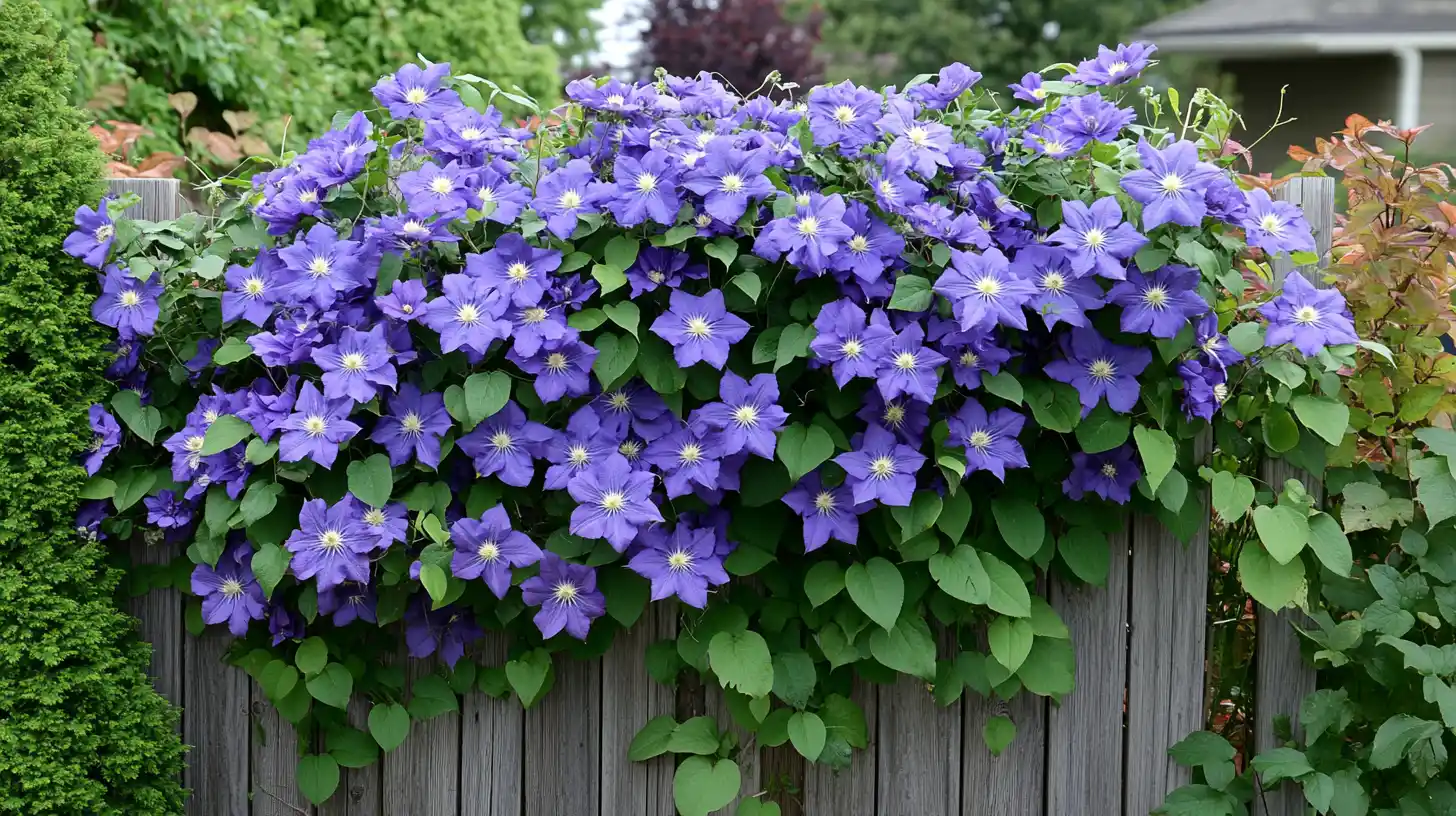Clematis vines are a gardener’s dream—beautiful, versatile, and surprisingly easy to grow once you understand their needs. Known for their stunning blooms and ability to climb with elegance, clematis can transform fences, arbors, and trellises into show-stopping focal points. Whether you’re just starting out or have years of digging in the dirt behind you, growing clematis vines is a rewarding endeavor that adds vertical drama and long-lasting charm to your garden. With the right variety and a few simple care tips, these perennials will return year after year, bigger and better than before.
🌿 Related: How to Grow and Care for Clematis
Table of Contents
Why Grow Clematis Vines?
Why Grow Clematis Vines?
If you’re looking to elevate your garden—literally and visually—growing clematis vines is one of the best choices for both beginner and seasoned gardeners. These long-living perennials grow stronger and more floriferous over time, offering unbeatable value and beauty in one plant.
Their climbing nature makes them ideal for creating vertical interest on trellises, fences, and even pergolas. With dozens of flower shapes and color options, clematis add seasonal flair in ways most perennials can’t. Best of all, they pair beautifully with other easy-care perennials to complete a layered, low-maintenance landscape.
🌿 Long-Lasting Perennials
Once established, clematis vines will come back year after year, often with more vigorous growth and fuller flowers. They’re an investment that keeps giving.
🌼 Stunning Variety
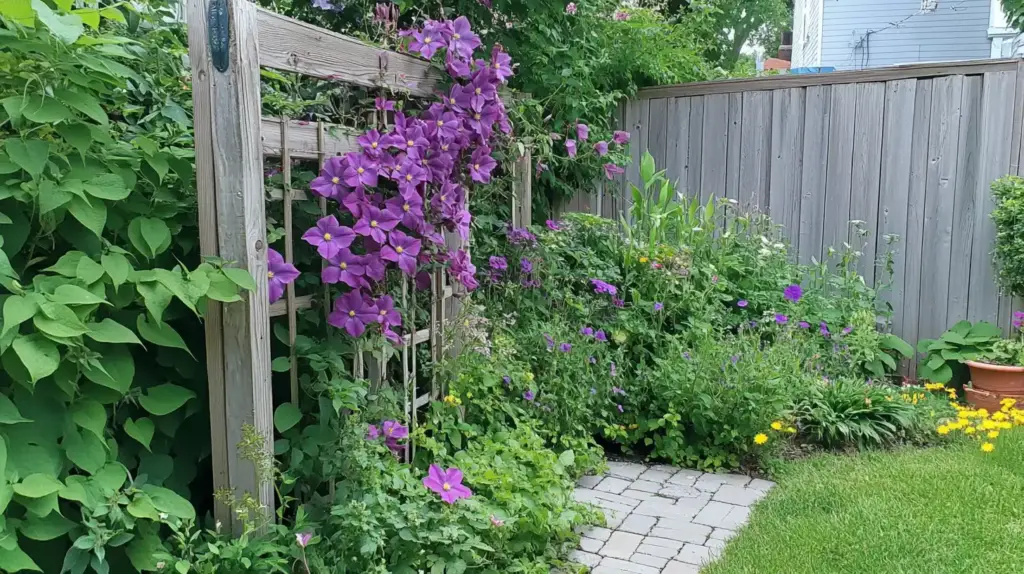
From large, star-shaped blooms to smaller, bell-like flowers, clematis varieties offer a wide palette of colors—lavender, deep purple, pink, white, and even bi-color. There’s a type for every aesthetic.
📏 Adds Height and Dimension
Unlike ground-hugging plants, clematis vines bring vertical interest. They’re perfect for dressing up trellises, obelisks, arbors, or even bare walls and fences.
🧑🌾 Great for Beginners and Pros
Clematis might seem fussy at first glance, but once you understand their basic needs, they’re quite easy to care for. With hundreds of varieties available, there’s something for both new gardeners and seasoned green thumbs.
Whether you want a fast grower to cover a structure quickly or a compact climber to mix among your perennials, clematis is a reliable and eye-catching choice.
Important Considerations Before Buying Clematis

Before you head to the garden center or fill your online cart, it’s essential to understand what you’re looking for. Not all clematis varieties are created equal, and selecting the right one for your space will make all the difference when growing clematis vines successfully.
🕒 Growth Rate Matters
Some clematis vines take off like rockets, while others prefer a slow and steady approach. If you’re after quick coverage, consider fast-growing varieties like:
- Sweet Autumn Clematis – vigorous with small, fragrant white blooms
- Jackmanii – a classic, deep purple favorite
- Warsaw Nike – a bold, fast climber with rich purple flowers
Slower types may take a few seasons to truly shine, so know your patience level before planting.
☀️ Light Requirements
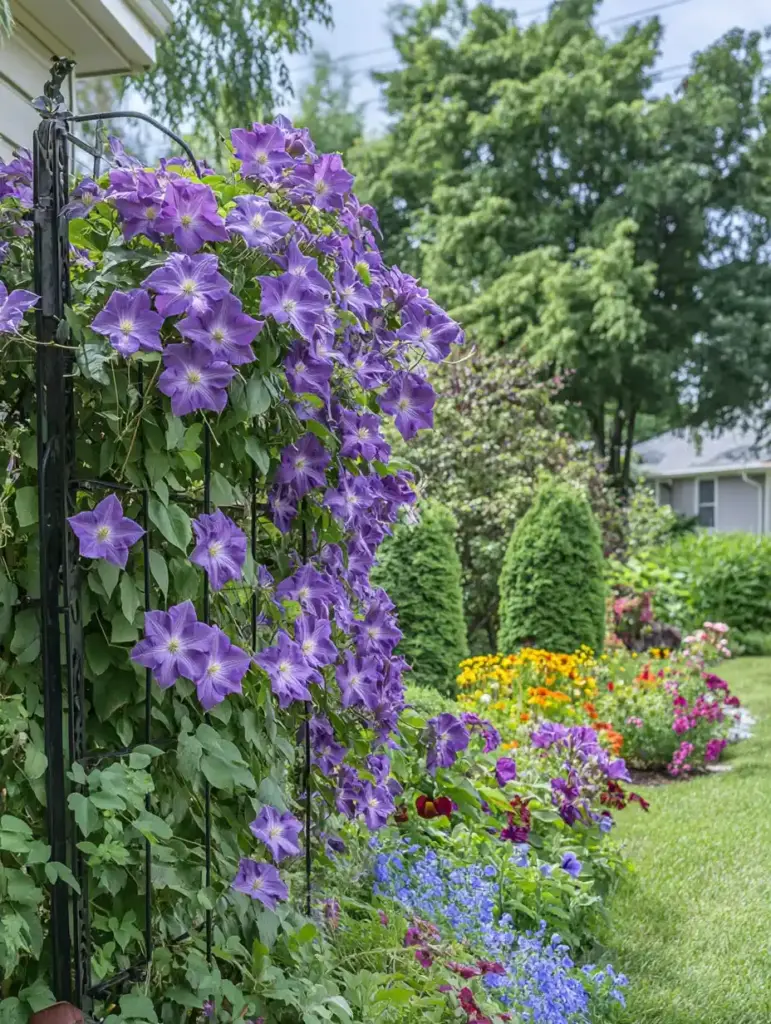
Clematis love sunlight, but with a twist. The golden rule is:
“Head in the sun, feet in the shade.”
- Top of the plant: Needs 6+ hours of sun daily for abundant blooms
- Root zone: Prefers cool, shaded conditions
To achieve this balance, plant low-growing perennials or add mulch around the base to keep the roots shaded and moist.
🌱 Soil and Site Prep
Clematis thrive in well-draining, rich soil. Before planting, amend your garden bed with compost to improve moisture retention and nutrient levels.
🐾 Pet Safety Tip
Some clematis varieties are toxic to cats and dogs if ingested. If you have curious pets that like to nibble, double-check the plant’s safety before buying—or plant them in inaccessible areas.
Choosing the right clematis means thinking ahead: where it will grow, how fast you want coverage, and whether it suits your sunlight and safety needs.
Supporting Clematis Growth
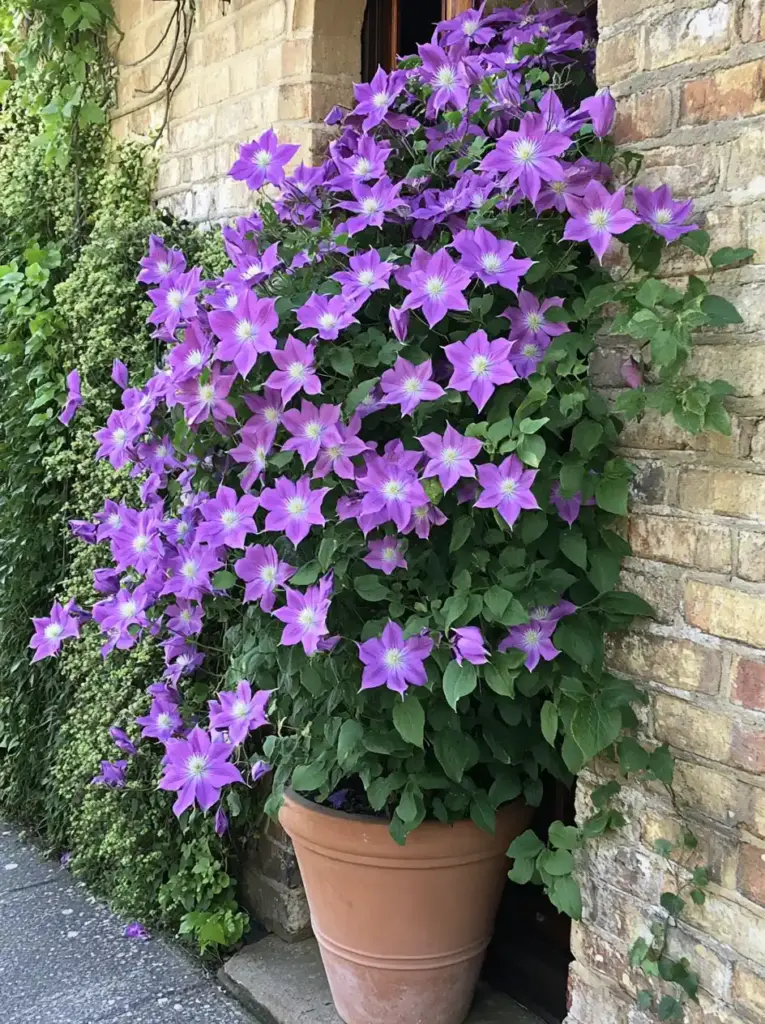
Once you’ve chosen your ideal variety, the next step in growing clematis vines is setting up the right kind of support. These vines aren’t aggressive climbers like some other species—they need a little help finding their way upward, and the support you provide will shape how they grow and bloom.
🧱 Choose the Right Structure
Clematis vines do best when given something to cling to or twine around. Before planting, have one of the following in place:
- Trellis – classic and versatile
- Arbor or archway – creates a dramatic entrance
- Fence – adds height and color to flat spaces
- Obelisk or tuteur – ideal for smaller gardens or containers
🌿 Understand Climbing Habits
Not all clematis climb the same way. Here’s how to work with their natural tendencies:
- Tendril-type clematis: These can grab onto narrow supports like netting, thin wires, or twigs.
- Non-clinging varieties: Will need to be gently tied to their structure using garden twine or soft ties—never use wire or anything that can cut into stems.
🌸 Bush-Type Clematis
Some clematis varieties are more shrub-like and don’t need vertical supports. These are perfect for:
- Filling garden beds
- Softening the edges of pathways
- Adding variety among other perennials
No matter the variety, always handle clematis vines gently—stems are notoriously fragile. Training your clematis early and providing steady support ensures strong, healthy growth and maximum blooms.
How to Plant Clematis Vines

Planting is a critical step in growing clematis vines—get it right, and your plant will reward you with years of stunning blooms. While clematis are relatively low-maintenance once established, they do have specific preferences when it comes to planting.
🗓️ When to Plant
The best time to plant clematis is early morning on a cloudy day. Overcast conditions reduce transplant stress and help your vine settle in more comfortably.
🔖 Read the Label
Before you dig, check the plant tag for variety-specific care tips. Labels usually include sun requirements, mature height, and pruning information—vital details for proper placement and future maintenance.
🌱 Step-by-Step Planting Instructions
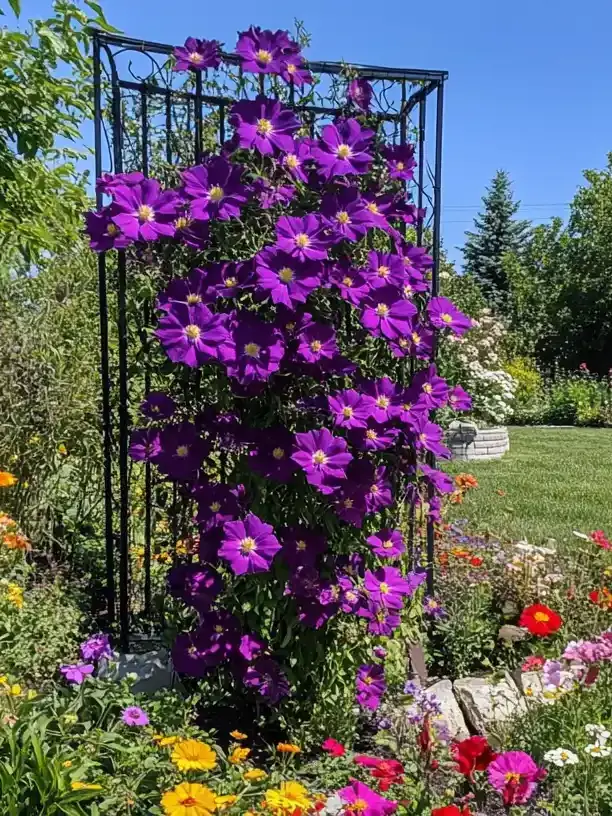
- Dig a Wide Hole
- Make it about twice as wide and deep as the plant’s pot.
- This gives roots room to spread and improves soil drainage.
- Amend the Soil
- Mix in rich organic compost or aged manure.
- If soil is dry or sandy, soak the hole with water and let it absorb.
- Remove the Plant Gently
- Never yank it out by the stem.
- Instead, squeeze the sides of the nursery pot, turn it upside down, and catch the root ball with your hand.
- Loosen the Roots
- Gently tease apart the root ball to encourage outward growth.
- Set the Plant at the Right Depth
- While some gardeners plant clematis 2–3 inches deeper than it was in the pot (to protect the crown and encourage stem rooting), others keep it level with the soil surface.
- You can choose either, but planting at the same depth is a safer starting point for most beginners.
- Backfill and Firm Down
- Use a mix of native soil and compost.
- Press down lightly to eliminate air pockets.
- Water Thoroughly
- Give the plant a deep watering right after planting to help it settle in.
Planting clematis the right way sets the stage for vigorous growth and bountiful flowering in the seasons to come.
Structural Tips for Success
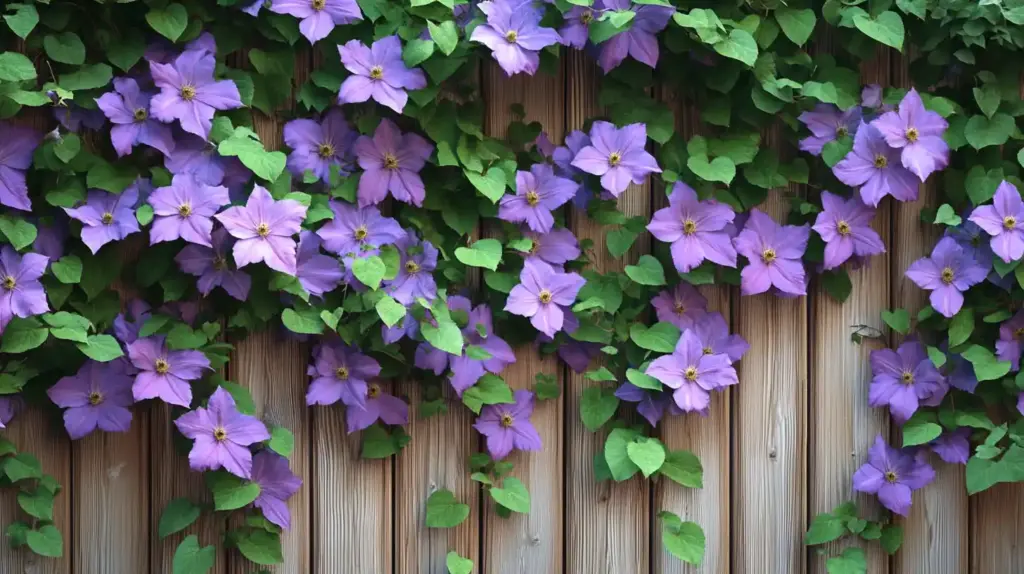
While planting and sunlight are crucial, one of the most overlooked aspects of growing clematis vines is setting up the right support system from day one. Clematis are delicate climbers, and when you’re focused on growing clematis vines successfully, proper handling and structural planning can make all the difference in how well they establish and flourish.
🧱 Install Support Before Planting
Always have your structure—whether it’s a trellis, arbor, or obelisk—in place before you plant your clematis. Installing it afterward risks damaging the vine or roots.
🤲 Be Gentle with Vines
Clematis stems are notoriously brittle, especially when young. When training them:
- Handle with care during tying or guiding.
- Avoid forcing vines into unnatural directions.
- Use soft plant ties (like twine or cloth strips) to avoid cutting into stems.
If a stem does snap, don’t panic—it won’t harm the overall plant. Simply prune the broken section back to a healthy node and let the vine redirect its energy.
🪴 Mulch and Water Supportively
To complement your structural support, be sure to:
- Mulch around the base to cool the roots and retain moisture.
- Water regularly, especially during the first growing season.
These extra touches help clematis establish strong roots, which will anchor them more securely to their climbing frame over time.
By combining gentle handling with thoughtful support, your efforts in growing clematis vines will set the stage for healthy growth and an abundance of vibrant blooms season after season.
Frequently Asked Questions (FAQ)
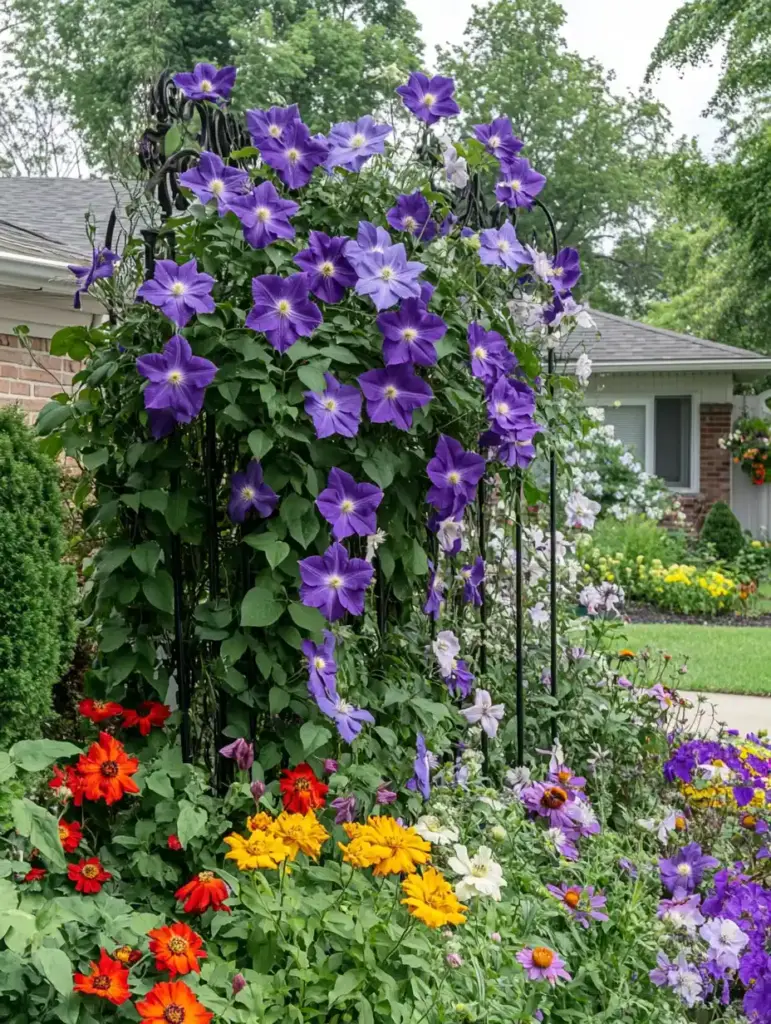
❓ When is the best time to plant clematis vines?
The ideal time for growing clematis vines is in early spring or fall, preferably on a cool, cloudy day. Planting during these milder seasons allows the roots to establish properly before the stress of summer heat or winter chill sets in.
❓ Do clematis vines need full sun?
Most clematis varieties prefer at least 6 hours of full sun per day. However, they thrive best when the roots are kept cool and shaded—a method known as “head in the sun, feet in the shade.”
❓ How long does it take for clematis to grow and bloom?
When growing clematis vines, patience is key—these beautiful climbers can take 1 to 3 years to become fully established. While some fast-growing varieties may bloom in their first year, others require more time to mature before rewarding you with abundant, long-lasting flowers.
❓ Should clematis be cut back?
Yes, but pruning depends on the variety. When growing clematis vines, it’s important to know they fall into three distinct pruning groups—some bloom on old wood, while others flower on new growth. Always check the plant tag or research your specific type to ensure you’re pruning at the right time for optimal blooms.
❓ Are clematis vines invasive?
No, growing clematis vines does not mean dealing with an invasive plant. While clematis grow vigorously, they don’t spread aggressively like some other vines. With regular pruning and a bit of structure, growing clematis vines remains a tidy and manageable addition to any garden.
❓ Can clematis grow in containers?
Yes! Compact or bush-type clematis varieties can be successfully grown in large containers, provided they have a support structure and consistent watering.
Conclusion

Whether you’re aiming to create a show-stopping trellis display or simply add some vertical flair to your flower beds, growing clematis vines is one of the most rewarding gardening projects you can take on. With the right variety, solid planting techniques, and a bit of thoughtful support, growing clematis vines can transform your garden year after year—becoming more vibrant, lush, and beautiful with each season.
Remember: sun on the head, shade on the feet, and a sturdy structure to climb. Follow these simple principles, and you’ll enjoy a garden full of elegance, color, and charm.

